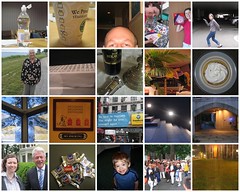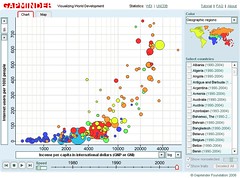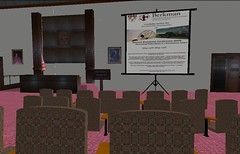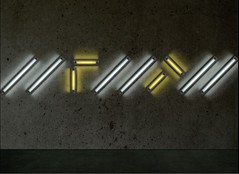by Eszter Hargittai on July 1, 2006

Looking for a summer [or insert appropriate season] hobby? Consider joining the Flickr Monthly Scavenger Hunt group!

Each month, you’re given a list of items for which you have to post photos. The challenge is made a bit easier by the fact that you can use photos taken at other times. (I think the really hard core version would not allow people to look in their archives, but it’s hard enough as is so it’s likely a reasonable rule.)
The July list has just been posted. It looks considerably harder than last month’s list, not that that was easy. I think for #8 “Hot pink” I can recycle my “Oink” entry from June. And probably few will have my particular take on #13 “Pest”. But what about entries like #11 “Most exotic animal for your location” or #14 “Road sign with wildlife on it”? This should be interesting…
by Eszter Hargittai on June 28, 2006
Via Jim Gibbon I’ve discovered Gapminder. Wow! It’s a wonderful visualization tool for data. The focus is on world development statistics from the UN. The tool is incredibly user-friendly and let’s you play around with what variables you want to see, what you want highlighted in color, whether you want to log the data, what year you want to display, and whether you want to animate the time progression (oh, and how quickly).
I’ve made an example available on YouTube. (I used Gapminder to create the visualization and Hypercam to capture it.)
Here is some context for that particular graph. My first interests in research on Internet and social inequality concerned the unequal global diffusion of the medium. I wrote my senior thesis in college on this topic and then pursued it further – and thankfully in a more sophisticated manner – in graduate school. So this is a topic that has been of interest to me for a while and it’s great to be able to play with some visual representations of the data.
So what you have on the video graph is a look at Internet diffusion by income (logged) from 1990-2004. I picked color coding by income category, which is somewhat superfluous given that the horizontal access already has that information, but I thought it added a little something. (For example, to summarize the puzzle of my 1999 paper – the first to run more than bivariate analyses on these data -, it focused on explaining why all the red dots are so widely dispersed on the graph despite all representing rich long-term democratic countries.)
Thanks to the tool’s flexibility, you can change it so that the color coding signifies geographical region and could then tell immediately that what continent you are on – an argument some people in the literature tried to make – has little to do with the level of Internet diffusion.

Imagine the possibilities of all this in, say, classroom presentations. Jim links to a great presentation using this tool. (Although I disagree with the presenter’s conclusion at the end about the leveling of differences regarding Internet diffusion.)
I recommend checking out the tool on your own for maximum appreciation of its capabilities.
UPDATE: There is more! Conrad – Jim’s source on this – tells me that the tool on the Trendalyzer site has even more option. Moreover, you can download a beta version of the software that even lets you import your own data.
by Eszter Hargittai on June 14, 2006
Thanks to all those who submitted entries in the Anonymous Lawyer contest. There are several funny submissions that merit being included in the final vote, but I thought more than five options would make it too cumbersome so I have limited the poll to five entries. Using input from Jeremy Blachman (the author of the Anonymous Lawyer book) the following entries are hereby declared finalists:
- The Double Mocha-Latte Drinking, Gel-Haired, Brown Courduroy Blazer Wearing Trendoid
- The Amazing Vanishing Advisor
- Prof-Who-Burnt-His-Beard-Off-With-That-Pretentious-Pipe
- The Apprentice Loser
- Mr Happy, who believes if something funny is worth saying once, it is worth saying a thousand times, the fucker.
Please vote for your favorite Anonymous Colleague description below the fold.
[click to continue…]
by Eszter Hargittai on May 29, 2006
Recently I stayed at an intriguing hotel that is worth a mention: the 21C Museum Hotel in Louisville, Kentucky. (I was unimpressed by the reservation part of the experience, but the stay made up for the annoyances incurred at that stage.)
Upon entrance, you almost have to step on the projection of two people sleeping in bed to get to the receptionists and/or the elevators to access your room. I wonder how many people who notice this just walk right across the image versus how many decide to walk around the picture. Big plastic red penguins are scattered across the building, not just in the designated museum section, but also in the hallways. I didn’t care for some of the installations (like the film about a woman and a man having a seemingly pleasant dinner judging from their facial expressions despite the fact that mice are walking all over their food), but some of it was neat (like the falling letters on a screen where the viewer becomes part of the image).
The hotel just opened this Spring. It’s a museum-hotel mix with various contemporary art pieces all over. The visit was much more fun than your usual hotel stay and it made me wish more hotels would put some interesting twist on the experience.
by Henry Farrell on May 25, 2006
Over the last few days we’ve been getting a new kind of comment spam; it’s semi-relevant to the posts in question, but has, if you look at it, links back to the usual kinds of websites. Unless artificial intelligence has improved a lot more than I think it has, I presume that real human beings are being paid to generate it, in the hope that it will slip under bloggers’ radar more easily than the automated stuff. If you’re a blogger at a reasonably well-trafficked site, you may want to keep an eye out for this.
by Eszter Hargittai on May 12, 2006

Today (Friday), the Berkman Center for Internet & Society at the Harvard Law School is hosting a conference on Reinventing Public Media in a Participatory Culture. In addition to the face-to-face discussions, the conference is also integrating digital media in neat ways for participation by those who can’t be at the meeting physically. For example, there is a Berkman Island (including a 3D replica of the Ames Courtroom at the Harvard Law School) in Second Life. If you get a chance, come join us, it looks like there will be some very interesting presentations and discussions.
by Belle Waring on April 8, 2006
I think this is my best spam email ever. It’s part Jonathan Livingston Seagull, and part Russian sci-fi:
“Why is it,” Jonathan puzzled, “that the hardest thing in the world is profoundly serious work, since every bent line illuminates a straight one. They were all just watching and grunting words of welcome, but not one was swift wind. Yet he felt guiltless, breaking the promises he had made.”
Bullshit stock hype, if you wondered. And I can hardly blame my mail; perhaps the coming AI kernel is building in the relentlessly negative spam-filter hive mind. Each time a nonsense phrase is chancily uplifted to poetic virtue the filter “stumbles” and allows it through.
by Eszter Hargittai on March 16, 2006
The University of Michigan Press is putting together a volume called The Best of Technology Writing 2006. The editorial team is soliciting suggestions for pieces, including blog posts.
[W]e’re asking readers to nominate their favorite tech-oriented articles, essays, and blog posts from the previous year. The competition is open to any and every technology topic–biotech, information technology, gadgetry, tech policy, Silicon Valley, and software engineering are all fair game. But the pieces that have the best chances of inclusion in the anthology will conform to these three simple guidelines:
1. They’ll be engagingly written for a mass audience; if the article requires a doctorate to appreciate, it’s probably not up our alley. Preference will be given to narrative features and profiles, “Big Think” op-eds that make sense, investigative journalism, sharp art and design criticism, intelligent policy analysis, and heartfelt personal essays.
2. They’ll be no longer than 5,000 words.
3. They’ll explore how technological progress is reshaping our world.
The resulting publication will be available both in book form and online.
Hop on over to digitalculture.org for more information and to submit your nominations.
by Eszter Hargittai on March 7, 2006
Via Lifehacker, I found a helpful video on how to peel potatoes without too much trouble. Not wanting to pass on a recommendation without having tried it myself, I dutifully boiled a potato to test the method. It worked great! Note that the water at the end doens’t have to be ice water, it’s enough to put the boiled potato in some cold water.
While we’re on the topic of how-to videos, if anybody missed the instructions for folding a shirt, it’s also worth a visit. I found it harder to follow than the potato-peeling guide though. It may help to look at this piece as well to figure out what’s going on. I haven’t made this technique part of my everydays, but depending on your current method you may decide differently.
by Eszter Hargittai on March 2, 2006
I started playing ping pong again a few weeks ago so I may appreciate this more than most, but I don’t think you have to be a practitioner for it to be worth a look.
While we’re on the topic of ping pong, check out this massively multiplayer online pong game. It’s not so much that it’s hours of fun (it’s not), what’s intriguing is that people come up with and create these things.
If all this has gotten you in the mood for some pong then try king pong [requires Shockwave]. It’s a pretty good version of a game that probably has hundreds if not thousands of variants.
I guess at this point I should probably include this here:  .
.
UPDATE: The world smallest pong game is also worthy of a link here (I forget how I first came upon it a few weeks ago).
Thanks to Geeked for the Ping pong link and Waxy for the MMOP link. I found King Pong all by myself (well, with a little help from a search engine).
by Eszter Hargittai on March 2, 2006






A propos gender, I wanted to say a few words about some recent photo interests. A few months ago I decided to start taking pictures of gender signs. The most obvious location for these is restroom doors. I haven’t encountered any awkward situations yet running around public bathrooms snapping photos, but I can imagine eventually I may get some curious glances.
The purpose of this exercise is to see what are the core essential elements that the designers of such signs decide will be enough to distinguish between men and women. We are all used to the stick figures, with and without the skirt (or would that be a dress?). But how about the more innovative approaches? In the Hungarian Parliament, the emphasis on the signs seems to be on differences in hairdo while the signs in the Hungarian Academy of Sciences emphasize some facial feature variation (lips vs moustache) in addition to hairdo distinctions and some differences in clothing. (It would be interesting to know the date of these two pairs of signs, I guess I didn’t do adequate research.) In other cases, the focus is on how men vs women tend to go about their business. At times, the distinctions are not completely obvious (these tend to be some of the most intriguing cases).
I have compiled my photos on the topic into a set on Flickr. More interestingly, I also started a public group on Flickr, a pool of pictures to which any other Flickr member can contribute. This has led to some great additions by others, for example: this Ken and Barbie pair at the Shirn museum in Frankfurt.
The rule for the photo pool is simple: post images that have both the male and female symbol (either in one or two pictures) and give some description of where the signs are located in case others want to find them. I welcome contributions! Join the trend, don’t be shy to whip out your camera next time you spot a pair of gender signs.
Eventually, I could see this project leading to.. well, perhaps not a coffee table book, but maybe a bathroom book?
by Eszter Hargittai on February 19, 2006

Let’s get those creative juices flowing. The Hayward Gallery is hosting Dan Flavin: A Retrospective (this seems to be the one that was at Chicago’s MCA recently) and has a fun interactive site to go along with it. You can create your own light installation dedications and add them to the pool. You can view other people’s here.

If you send yourself a copy of the image you create then you’ll have a URL to it like the one for the image above. Feel free to post a link to your creations in the comments.
by Eszter Hargittai on February 17, 2006
 Train stations often (or sometimes?) have meeting points where people can arrange – surprise-surprise – to meet up with others. This can be helpful if you don’t know the train station at all since you can just decide to meet at the point and then look for it once there. It’s also helpful if you do know the train station since you can avoid having to address the question of specific meeting location every time you’re meeting up with someone.
Train stations often (or sometimes?) have meeting points where people can arrange – surprise-surprise – to meet up with others. This can be helpful if you don’t know the train station at all since you can just decide to meet at the point and then look for it once there. It’s also helpful if you do know the train station since you can avoid having to address the question of specific meeting location every time you’re meeting up with someone.
I was at the Zürich train station last week and noticed an interesting twist on all this: the ebay Xchange point. I had never seen one before. It looks like a really clever way to advertise the service. Not only is it an ad for the auction site, it is also a very helpful place for people to meet up to exchange items bought and sold on ebay. While people could just say “see you at the meeting point” that’s less helpful when you have never met the person before and since the regular meeting point tends to get quite crowded at times, it’s useful to have a separate location for these exchanges.
Anyone know of other such points elsewhere? Extra credit for having pictures of other such locations.:)
by Eszter Hargittai on February 5, 2006
I have a piece over at Lifehacker on unique photo gift ideas. I covered personalized gift cards, movie posters and magazine covers, a memory game from photos, magnets and a few other ideas. I have already given some of these as gifts, not all. I’d be curious to hear what personalized gifts others have given or received that were especially big hits. I enjoy giving gifts to people – and have a bunch of gift-giving occasions coming up -, but prefer the personal touch to the off-the-shelf options. Budget-conscious solutions are especially welcomed.
by Henry Farrell on February 1, 2006
Two interesting perspectives on the James Frey affair.
First, “Scott McLemee”:http://www.insidehighered.com/views/2006/02/01/mclemee (who is celebrating his one year anniversary as a columnist at _Inside Higher Ed_ today).
bq. Why the furor over Frey? “I think the vilification he has been subject to in the media is extreme,” writes Farr, “and probably stems from some larger discomfort about dishonesty from sources who are (and ought to be ) culturally more responsible to the ‘ascertainable facts.’” There may be something to that. And yet it begs any number of questions. The man has made a small fortune off of fabricating a life and selling it — while loudly talking, in the very same book, about the personally transformative power of “the truth.” Oprah Winfrey endorsed it, and (at first anyway) insisted that mere factual details were subordinate to a larger truth… A personal truth….A truth that, it seems, is accountable to nothing and nobody. Suppose this becomes an acceptable aspect of public life – so that it seems naive to be surprised or angered by it. Then in what sense can we expect there to be institutions that, in Farr’s words, “are (and ought to be ) culturally more responsible to the ‘ascertainable facts’”?
Second, “Patrick Nielsen Hayden”:http://nielsenhayden.com/makinglight/archives/007215.html#007215 at _Making Light_.
bq. Echoing Maureen Dowd, Arianna Huffington is exercised over the fact that James Frey’s memoir A Million Little Pieces, now comprehensively exposed as fraudulent baloney, is still listed by the New York Times on their nonfiction paperback bestseller list. … This is a silly argument because calling a book “nonfiction” has never meant any kind of certification that its contents are true. Edgar Cayce books are “nonfiction.” Immanuel Velikovsky is “nonfiction.” Self-published tracts about how bees from Venus are attacking Your Child’s Brain are “nonfiction.” All of these are packs of lies. They’re also not fiction, which is to say, narratives put forth under the rubric of “I’m now going to tell you a story which I made up.” Yes, there are books which fall into a gray area. (Into which category would you put Avram Davidson’s _Adventures in Unhistory?_ You have five minutes. Show your work.) A Million Little Pieces isn’t one of those books, any more than “this”:http://www.amazon.com/gp/product/B000C4SV2I/qid=1138715421/sr=2-1/ref=pd_bbs_b_2_1/102-3450522-9649706?s=books&v=glance&n=283155 particular pack of lies. What’s more, as an editor devoted to the value of good fiction, I wouldn’t want the Times, or anyone else, to start using “fiction” as a dumping-ground for works of nonfiction which have proved to be full of lies. There’s a good discussion to be had of whether respectable book publishers should make a greater effort to ensure the basic truthfulness, or at least truthful intention, of work published as “nonfiction.” But using “fiction” as a synonym for “lying” isn’t the way to go.
As always in _Making Light_, there’s more meat in the comments (including the utterly wonderful news that Avram Davidson’s _Adventures in Unhistory_ is being re-released by Tor in December).




 .
.






